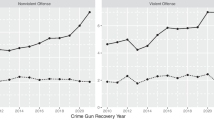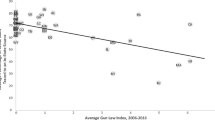Abstract
Firearms have widely supported legitimate purposes but are also frequently used in violent crimes. Owners and senior executives of federally licensed firearms dealers and pawnbrokers are a potentially valuable source of information on retail commerce in firearms, links between legal and illegal commerce, and policies designed to prevent the firearms they sell from being used in crimes. To our knowledge, there has been no prior effort to gather such information. In 2011, we conducted the Firearms Licensee Survey on a probability sample of 1,601 licensed dealers and pawnbrokers in the United States believed to sell 50 or more firearms per year. This article presents details of the design and execution of the survey and describes the characteristics of the respondents and their business establishments. The survey was conducted by mail, using methods developed by Dillman and others. Our response rate was 36.9 % (591 respondents), similar to that for other establishment surveys using similar methods. Respondents had a median age of 54; 89 % were male, 97.6 % were White, and 98.1 % were non-Hispanic. Those who held licenses under their own names had been licensed for a median of 18 years. A large majority of 96.3 % agreed that “private ownership of guns is essential for a free society”; just over half (54.9 %) believed that “it is too easy for criminals to get guns in this country.” A match between the job and a personal interest in the shooting sports was the highest-ranking reason for working as a firearms retailer; the highest-ranking concerns were that “there are too many ‘gun control’ regulations” and that “the government might confiscate my guns.” Most respondents (64.3 %) were gun dealers, with significant variation by region. Residential dealers accounted for 25.6 % of all dealers in the Midwest. Median annual sales volume was 200 firearms for both dealers and pawnbrokers. Dealers appeared more likely than pawnbrokers to specialize; they were more likely to rank in the highest or lowest quartile on sales of handguns, inexpensive handguns, and tactical rifles. Sales of inexpensive handguns and sales to women were more common among pawnbrokers. Internet sales were reported by 28.3 % of respondents and sales at gun shows by 14.3 %. A median of 1 % of sales were denied after purchasers failed background checks; firearm trace requests equaled <1 % of annual sales. Trace frequency was directly associated with the percentage of firearm sales involving handguns, inexpensive handguns, and sales to women. Frequency of denied sales was strongly and directly associated with frequency of trace requests (p < 0.0001). These results are based on self-report but are consistent with those from studies using objective data.


Similar content being viewed by others
References
Truman JL, Rand MR. Criminal victimization, 2009. Washington, DC: Bureau of Justice Statistics, 2010. NCJ 231327.
Murphy SL, Xu J, Kochanek KD. Deaths: preliminary data for 2010. Natl Vital Stat Rep. 2012; 60(4): 1–69.
Bureau of Alcohol, Tobacco and Firearms. Following the gun: enforcing federal laws against firearms traffickers. Washington, DC: Bureau of Alcohol, Tobacco and Firearms; 2000.
Braga AA, Cook PJ, Kennedy DM, Moore MH. The illegal supply of firearms. In: Tonry M, ed. Crime and justice: a review of research. Vol 29. Chicago: The University of Chicago Press, Chicago and London; 2002: 319–352.
Pierce GL, Braga AA, Hyatt RRJ, Koper CS. Characteristics and dynamics of illegal firearms markets: implications for a supply-side enforcement strategy. Justice Q. 2004; 21(2): 391–422.
Koper CS. Federal legislation and gun markets: how much have recent reforms of the federal firearms licensing system reduced criminal gun suppliers? Criminol Public Pol. 2002; 1(2): 151–178.
Sorenson SB, Vittes K. Buying a handgun for someone else: firearm dealer willingness to sell. Inj Prev. 2003; 9(2): 147–150.
Webster D, Vernick J, Bulzacchelli M. Effects of a gun dealer's change in sales practices on the supply of guns to criminals. J Urban Health. 2006; 83(5): 778–787.
Webster D, Bulzacchelli M, Zeoli A, Vernick J. Effects of undercover police stings of gun dealers on the supply of new guns to criminals. Inj Prev. 2006; 12(4): 225–230.
Webster DW, Vernick JS, Bulzacchelli MT, Vittes KA. Temporal association between federal gun laws and the diversion of guns to criminals in Milwaukee. J Urban Health. 2012; 89(1): 87–97.
Wintemute GJ, Cook P, Wright MA. Risk factors among handgun retailers for frequent and disproportionate sales of guns used in violent and firearm related crimes. Inj Prev. 2005; 11(6): 357–363.
Wintemute GJ. Disproportionate sales of crime guns among licensed handgun retailers in the United States: a case-control study. Inj Prev. 2009; 15(5): 291–299.
Wintemute GJ. Firearm retailers' willingness to participate in an illegal gun purchase. J Urban Health. 2010; 87(5): 865–878.
Wintemute GJ. Inside gun shows: what goes on when everybody thinks nobody's watching. Sacramento: Violence Prevention Research Program; 2009.
Wright MA, Wintemute GJ, Webster DW. Factors affecting a recently-purchased handgun's risk for use in crime under circumstances that suggest gun trafficking. J Urban Health. 2010; 87(3): 352–364.
Bureau of Alcohol, Tobacco Firearms and Explosives. Downloadable lists of Federal Firearms Licensees (FFLs). Available at: http://www.atf.gov/about/foia/ffl-list.html. Accessed March 18, 2011.
Bureau of Alcohol, Tobacco Firearms and Explosives. Permanent Brady permit chart. Available at: http://www.atf.gov/firearms/brady-law/permit-chart.html. Accessed December 10, 2009.
Bowling M, Frandsen RJ, Lauver GA, Boutilier AD, Adams DB. Background checks for firearms transfers, 2009 - statistical tables. Washington, DC: Bureau of Justice Statitics, 2010. NCJ 231679.
SAS for Windows [computer program]. Version 9.1.3. Cary, NC: SAS Institute; 2003.
Dillman D, Smith J. Internet, mail, and mixed-mode surveys: the tailored design method. 3rd ed. Hoboken: John Wiley & Sons, Inc; 2009.
Bureau of Justice Statistics. Survey of state procedures related to firearm sales, midyear 2004. St. Louis, Missouri: Bureau of Justice Statistics, August, 2005. NCJ 209288.
Dillman DA, Gertseva A, Mahon-Haft T. Achieving usability in establishment surveys through the application of visual design principles. J Off Stat. 2005; 21(2): 183–214.
Wintemute GJ, Wright MA. Swimming pool owners' opinions of strategies for prevention of drowning. Pediatrics. 1990; 85(1): 63–69.
Romero MP, Wintemute GJ, Vernick JS. Characteristics of a gun exchange program, and an assessment of potential benefits. Inj Prev. 1998; 4(3): 206–210.
Federal Bureau of Investigation. Total NICS background checks. Current version available at: http://www.fbi.gov/about-us/cjis/nics/reports/04032012_1998_2012_monthly_yearly_totals.pdf. Accessed November, 2010.
The American Association for Public Opinion Research. Standard definitions: final dispositions of case codes and outcome rates for surveys. 7th edition. 2011.
Bureau of Alcohol, Tobacco and Firearms. ATF snapshot 1999. Available at: http://www.atf.gov/publications/general/snapshots/atf-snapshot-1999.html. Accessed November 10, 2010.
Koper CS. Purchase of multiple firearms as a risk factor for criminal gun use: implications for gun policy and enforcement. Criminol Public Pol. 2005; 4(4): 749–778.
Bureau of Alcohol, Tobacco and Firearms. Commerce in firearms in the United States. Washington, DC: Bureau of Alcohol, Tobacco and Firearms; 2000.
Paxson MC, Dillman DA, Tarnai J, et al. Improving response to business mail surveys. In: Cox BG, Binder DA, Chinnappa BN, eds. Business survey methods. New York: John Wiley & Sons, Inc; 1995: 303–315.
Kriauciunas A, Parmigiani A, Rivera-Santos M. Leaving our comfort zone: integrating established practices with unique adaptations to conduct survey-based strategy research in nontraditional contexts. Strateg Manage J. 2011; 32(9): 994–1010.
Johnson TP, Wislar JS. Response rates and nonresponse errors in surveys. JAMA. 2012; 307(17): 1805–1806.
Voigt LF, Koepsell TD, Daling JR. Characteristics of telephone survey respondents according to willingness to participate. Am J Epidemiol. 2003; 157(1): 66–73.
Keane L. Firearm industry warns retailers of anti-gun survey. National Shooting Sports Foundation, 2011. Available at: http://www.nssfblog.com/firearms-industry-warns-retailers-of-anti-gun-survey/. Accessed June 18, 2011.
National Rifle Association. Warning—anti-gun survey of firearms dealers under way! National Rifle Association, 2011. Available at: http://www.nraila.org/legislation/federal-legislation/2011/6/warning-anti-gun-survey-of-firearms.aspx. Accessed June 30, 2011.
National Rifle Association Institute for Legislative Action. Warning—anti-gun survey of firearms dealers under way! [E-mail communication]. Personal communication to Wintemute GJ, June 29, 2011.
Keane L. Retailers heeding industry's caution of anti-gun survey. National Shooting Sports Foundation, 2011. Available at: http://www.nssfblog.com/retailers-heeding-industry’s-caution-of-anti-gun-survey/. Accessed July 13, 2011.
Keane L. Anti-gun survey continues to make the rounds; retailers heed industry's caution. National Shooting Sports Foundation, 2011. Available at: http://www.nssfblog.com/anti-gun-survey-continues-to-make-the-rounds-retailers-heed-industry%E2%80%99s-caution/. Accessed September 1, 2011.
Wintemute GJ. Association between firearm ownership, firearm-related risk and risk reduction behaviours and alcohol-related risk behaviours. Inj Prev. 2011; 17(6): 422–427.
Hassol A, Harrison H, Rodriguez B, Jarmon R, Frakt A. Survey completion rates and resource use at each step of a Dillman-style multi-modal survey. Presented at the American Association of Public Opinion Research annual meeting, May 15-18, 2003, Nashville, TN, USA. Available at http://www.abtassociates.com/presentations/AAPOR-2.html. Accessed May 9, 2012.
Acknowledgments
We are especially grateful to the retailers who participated in the survey, many of whom provided additional helpful comments. Barbara Claire, Vanessa McHenry, and Mona Wright provided expert technical assistance throughout the project. Dr. Tom Smith served as a consultant for the development of the survey questionnaire and gave extensive input. Jeri Bonavia, Kristen Rand, and Josh Sugarmann provided helpful reviews of a draft questionnaire.
Project support
This project was supported in part by a grant from The California Wellness Foundation. Initial planning was also supported in part by a grant from the Joyce Foundation.
Author information
Authors and Affiliations
Corresponding author
Additional information
Submitted to the Journal of Urban Health on May 22, 2012.
Appendix: Supplemental Tables and Figures
Appendix: Supplemental Tables and Figures
Rights and permissions
About this article
Cite this article
Wintemute, G.J. Characteristics of Federally Licensed Firearms Retailers and Retail Establishments in the United States: Initial Findings from the Firearms Licensee Survey. J Urban Health 90, 1–26 (2013). https://doi.org/10.1007/s11524-012-9754-y
Published:
Issue Date:
DOI: https://doi.org/10.1007/s11524-012-9754-y











